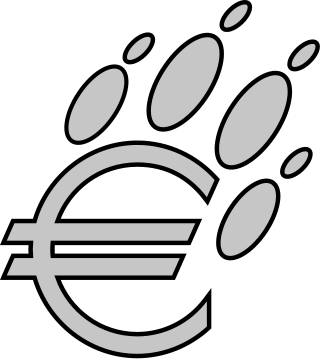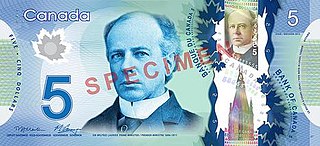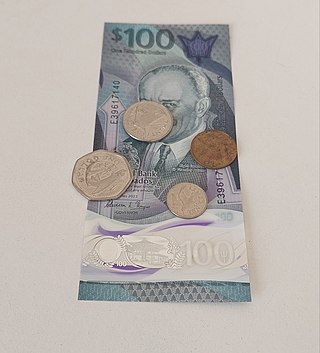
The Canadian dollar is the currency of Canada. It is abbreviated with the dollar sign $. There is no standard disambiguating form, but the abbreviations Can$, CA$ and C$ are frequently used for distinction from other dollar-denominated currencies. It is divided into 100 cents (¢).

The króna or krona is the currency of Iceland.
Federal Reserve Notes are the currently issued banknotes of the United States dollar. The United States Bureau of Engraving and Printing produces the notes under the authority of the Federal Reserve Act of 1913 and issues them to the Federal Reserve Banks at the discretion of the Board of Governors of the Federal Reserve System. The Reserve Banks then circulate the notes to their member banks, at which point they become liabilities of the Reserve Banks and obligations of the United States.
The South African rand, or simply the rand, is the official currency of South Africa. It is subdivided into 100 cents, and a comma separates the rand and cents.

The Malaysian ringgit is the currency of Malaysia. Issued by the Central Bank of Malaysia, it is divided into 100 cents.

Currency bill tracking is the process of tracking the movements of banknotes, similar to how ornithologists track migrations of birds by ringing them. It is usually facilitated by any one of a number of websites set up for the purpose, which can track currency among the users of that website. A user may register a bill by entering its serial number, and if someone else has already registered the bill, then the "route" of the bill can be displayed.

EuroBillTracker (EBT) is a website designed for tracking euro banknotes. It was inspired by the US currency bill tracking website Where's George? The aim is to record as many notes as possible to know details about their distribution and movements, follow it up, like where a note has been seen in particular, and generate statistics and rankings, for example, in which countries there are more tickets. EuroBillTracker has registered over 220 million notes with a combined total value of more than €4 billion as of September 2023.

The United States one-hundred-dollar bill (US$100) is a denomination of United States currency. The first United States Note with this value was issued in 1862 and the Federal Reserve Note version was first produced in 1914. Inventor and U.S. Founding Father Benjamin Franklin has been featured on the obverse of the bill since 1914, which now also contains stylized images of the Declaration of Independence, a quill pen, the Syng inkwell, and the Liberty Bell. The reverse depicts Independence Hall in Philadelphia, which it has featured since 1928.

The Reichsmark was the currency of Germany from 1924 until the fall of Nazi Germany in 1945, and in the American, British and French occupied zones of Germany, until 20 June 1948. The Reichsmark was then replaced by the Deutsche Mark, to become the currency of West Germany and then all of Germany after the 1990 reunification. The Reichsmark was used in the Soviet occupation zone of Germany until 23 June 1948, where it was replaced by the East German mark. The Reichsmark was subdivided into 100 Reichspfennig. The Mark is an ancient Germanic weight measure, traditionally a half pound, later used for several coins; Reich comes from the official name for the German state from 1871 to 1945, Deutsches Reich.

The Rentenmark was a currency issued on 15 November 1923 to stop the hyperinflation of 1922 and 1923 in Weimar Germany, after the previously used "paper" Mark had become almost worthless. It was subdivided into 100 Rentenpfennig and was replaced in 1924 by the Reichsmark.

The Canadian five-dollar note is the lowest denomination and one of the most common banknotes of the Canadian dollar.

The dollar has been the currency of Barbados since 1935. Globally its currency has the ISO 4217 code BBD, however, unofficially in Barbados the International vehicle registration code BDS is also commonly used, a currency code that is otherwise reserved for Bangladesh outside Barbados. As such the present Barbados dollar has the official ISO 4217 code of BB which matches the [dot] .bb Cc-TLD domain names classification for Barbados under ISO 3166, plus D for dollar in the foreign exchange market. The Barbadian dollar is considered as a currency which can be divided into 100 cents, though the 1 cent coin is in the process of being phased out.

The history of Canadian currencies began with Indigenous peoples in Canada prior to European contact, when they used items such as wampum and furs for trading purposes. The Indigenous peoples continued to use those items as currency when trade with Europeans began. During the period of French colonization, coins were introduced, as well as one of the first examples of paper currency by a western government. During the period of British colonization, additional coinage was introduced, as well as banknotes. The Canadian colonies gradually moved away from the British pound and adopted currencies linked to the United States dollar. With Confederation in 1867, the Canadian dollar was established. By the mid-20th century, the Bank of Canada was the sole issuer of paper currency, and banks ceased to issue banknotes.

Banknotes of the Canadian dollar are the banknotes or bills of Canada, denominated in Canadian dollars. Currently, they are issued in $5, $10, $20, $50, and $100 denominations. All current notes are issued by the Bank of Canada, which released its first series of notes in 1935. The Bank of Canada has contracted the Canadian Bank Note Company to produce the Canadian notes since then. The current series of polymer banknotes were introduced into circulation between November 2011 and November 2013. Banknotes issued in Canada can be viewed at the Bank of Canada Museum in Ottawa.

Where's George? is a website that tracks the natural geographic circulation of American paper money. Its popularity has led to the establishment of a number of other currency tracking websites and sites that track other objects, such as used books. Statistics generated by the website have been used in at least one research paper to study patterns of human travel in the United States.

Birds of Canada is the fifth series of banknotes of the Canadian dollar issued by the Bank of Canada and was first circulated in 1986 to replace the 1969 Scenes of Canada series. Each note features a bird indigenous to Canada in its design. The banknotes weigh 1 gram with dimensions of 152.40 by 69.85 millimetres. It was succeeded by the 2001 Canadian Journey series.
Slang terms for money often derive from the appearance and features of banknotes or coins, their values, historical associations or the units of currency concerned. Within a language community, some of the slang terms vary in social, ethnic, economic, and geographic strata but others have become the dominant way of referring to the currency and are regarded as mainstream, acceptable language.

Monopoly money is a type of play money used in the board game Monopoly. It is different from most currencies, including the American currency or British currency upon which it is based, in that it is smaller, one-sided, and does not have different imagery for each denomination.
The Salt Spring Dollar is a local currency issued by the Salt Spring Island Monetary Foundation to promote local history, art and goodwill on Salt Spring Island, British Columbia, Canada.
The eighth series of banknotes of the Canadian dollar was first released by the Bank of Canada in 2018. Like the preceding 2011 Frontier series, the 2018 series consists of polymer banknotes designed for increased durability and to incorporate more security features. It is the first series issued by the Bank of Canada printed in a vertical configuration.














